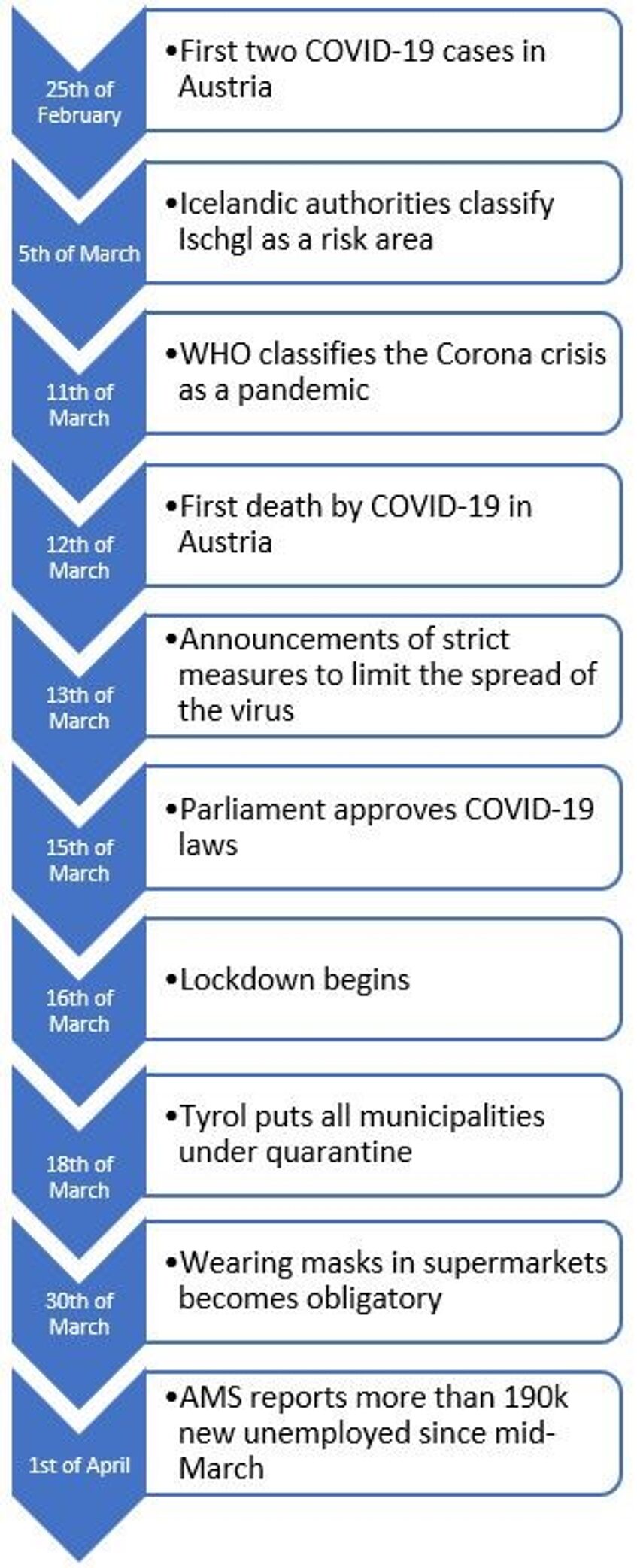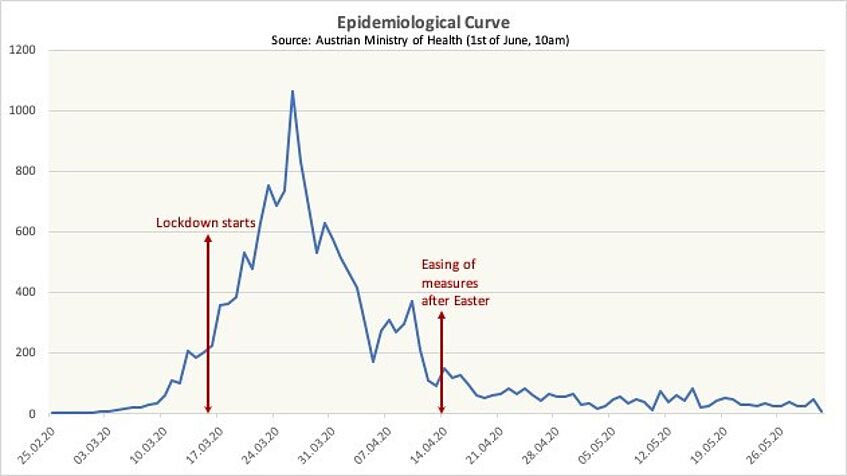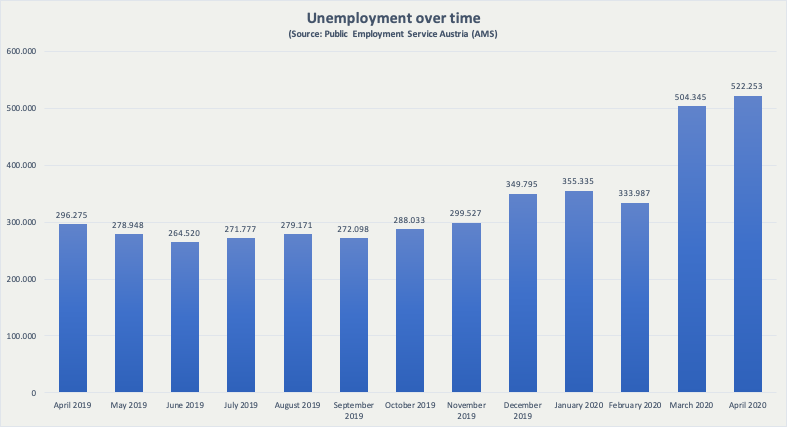03.06.2020
Chronology of the Corona Crisis in Austria - Part 1: Background, the way to the lockdown, the acute phase and economic consequences
- After the first confirmed coronavirus cases in Austria at the end of February, the federal government took drastic measures to contain the corona virus from mid-March onwards.
- On 26 March, according to the epidemiological curve, the maximum number of confirmed cases of infection in a single day was recorded. Subsequently, the peak of active, confirmed cases of infection was reached at the beginning of April. From then on, the number of confirmed coronavirus cases decreased.
- Until mid-April, public life in Austria remained severely restricted by government measures. Unemployment rose sharply by the end of March. After Easter, the first easing measures were implemented.
Von Markus Pollak, Nikolaus Kowarz und Julia Partheymüller
The novel coronavirus spread worldwide within a few months. After the first coronavirus cases had tested positive in Austria at the end of February, the federal government took drastic measures to contain the pandemic from mid-March onwards. As a result, public life almost came to a standstill for approximately a month. Despite the introduction of the measures, the number of reported cases continued to rise daily until the peak of active, confirmed cases of infection was reached in early April. As the number of new infections gradually declined and the considerable economic consequences became apparent, the first easing of measures was considered from mid-April. In light of the dramatic events, this first part of our Corona Chronology provides an overview of the early history of the spread of the coronavirus, the path to the lockdown in Austria, the dynamics of the infection process and the economic consequences of the pandemic so far. The article ends with the first easing of measures starting at Mid-April, which we will discuss in part 2 of the Corona Chronology.
Background
The first confirmed coronavirus cases were reported on 1 December 2019 in the Chinese province of Hubei. At that time it was assumed that the previously unknown virus had already spread in China in November. Although the origin of the virus has not yet been conclusively clarified, the city of Wuhan with its 11 million inhabitants was particularly affected by the first major outbreak, whereupon the Chinese central government enforced a strict lockdown from 23 January 2020. While attention in the first weeks of 2020 was mainly focused on the situation within China and on outbreaks in other Asian countries such as South Korea, the latest state of knowledge suggests that the virus reached Europe unnoticed even in this early phase. For example, first coronavirus cases in France were retrospectively confirmed for 27 December 2019. However, cases in Europe did not become publicly known until the end of January when the first cases were reported in France. Cases in other European countries followed shortly after, including reports of a first cluster in Germany at the automotive supplier Webasto and first cases in Lombardy in northern Italy, where the situation worsened dramatically in the following weeks.
The early phase: The coronavirus in Austria
While Austria initially did not appear to be affected by the spreading, on 25 February 2020 coronavirus was diagnosed for the first time in Austria in two 24-year-old women from Italy (see Figure 1 for an overview). On 27 February 2020, Health Minister Anschober and Minister of the Interior Nehammer informed the Austrian Parliament about recent developments and about upcoming national guidelines for handling the virus. The ministers spoke out "against panic-mongering" and in favour of joint crisis management.

Figure 1: Overview of the most important events
The coronavirus initially spread particularly in western Austria. The Icelandic authorities already declared Ischgl as a risk area on 5 March because Icelandic tourists with coronavirus infections had returned from their holiday. This step initially received little public attention in Austria. More attention was paid to the announcement of a decree which introduced health checks at the border with Italy the next day.
The acute phase: The way to the lockdown and the dynamics of infections
From 10 March, the government responses and the public perception of the crisis evolved rapidly. Almost every day the Federal Government announced new measures: Events were to be cancelled and "social distancing" was to be practised. On the following day, the closure of universities was announced by 16 March at the latest, although several universities anticipated this deadline. In addition, the schools had to close by 18 March.
The World Health Organization (WHO) classified COVID-19 as a global pandemic on 11 March. In addition, it was announced on 12 March that a 69-year-old holidaymaker in Italy was the first Austrian victim to die in Vienna. Visits to hospitals were banned on the same day.
Following announcements of further restrictions by Health Minister Anschober and Federal Chancellor Kurz on 13 March, panic buying was witnessed throughout Austria, overloading the supply chains for particularly sought-after products in the days that followed. Ischgl, Kappl, See, Galtür and Sankt Anton am Arlberg were the first municipalities to be quarantined for an initial period of 14 days. In addition, Minister of Health Anschober announced a ban on visits to nursing homes. On March 14, a new model for short-time work and a crisis response fund to mitigate the economic consequences of the crisis, were announced. Finance Minister Blümel announced that the goal of zero deficit would be abandoned.
On Sunday 15 March, in an unprecedented session, the Austrian Parliament voted unanimously in favour of the COVID-19 law, which created a legal basis for further restrictions of public life and was the first of a series of COVID-specific legislative packages. Never before in the Austrian Second Republic had a comparable legislative package been passed in the Parliament at such speed.
On 16 March a strict lockdown began. All shops apart from basic supply as well as the federal parks and public baths had to remain closed until further notice. Air traffic was largely suspended. Strict contact regulations and curfews based on the COVID-19 law came into force and brought public life almost to a standstill. Restaurants, cafés and bars were closed the following day.
On 18 March, two days after the early end of the skiing season, Tyrol put all municipalities under quarantine. On 20 March, tightened curfews were announced and the population was told to work from home if possible. A second COVID-19 law was passed and among other novelties, sports facilities and health resorts were to be closed. On 25 March, the Red Cross published the much-discussed Stopp-Corona-App, which is intended to trace chains of infection [1].
The government decided to oblige the population to use masks in supermarkets by 30 March and Chancellor Kurz stated Austria would experience a "calm before the storm". However, the measures seemed to already have an effect at that time as the peak of the epidemiological curve in terms of confirmed new infections was already reached on 26 March (see Figure 2). On that day, 1,063 people were infected. After that, the number continued to decrease until mid-April. The maximum number of tested, active coronavirus cases was reached on 3 April, when more than 9,000 people were considered infected (see Figure 3). From then on, both new infections and the total amount of confirmed cases declined. On April 4, the number of new cases of recovery exceeded the number of reported new infections for the first time. At that time, 231 people in Austria had died of coronavirus.[2]

Figure 2: Epidemiological Curve

Figure 3: Number of confirmed COVID-19 cases (cumulative) and number of recoveries, active cases and deaths
The declining phase: Decreasing incidence of coronavirus, dramatic economic consequences
From the beginning of April, the number of confirmed coronavirus cases decreased, but the dramatic economic consequences increasingly received public attention. According to the Austrian Public Employment Service (AMS), unemployment jumped by 199,934 new unemployed between mid-March and the beginning of April (see also Figure 4). According to AMS, the most affected sectors so far are tourism, construction, temporary work (personnel leasing, etc.) and commerce. According to the national definition, the unemployment rate at the end of March was an estimated 12.2% - an increase of +4.7 percentage points compared to March 2019.

Figure 4: Unemployment over time, April 2020
In light of the dramatic economic consequences and the successful containment of the risk of infection, an initial easing of measures was decided for the 14 April. On 6 April, for example, the government announced that shops beyond basic services would be allowed to reopen after Easter - with a simultaneous extension of the obligation to wear a mask in public transport and all shops that were not affected previously.
Conclusion
While it was assumed at the beginning of 2020 that the new coronavirus mainly affected China, the virus spread increasingly in Europe in the subsequent weeks and months and reached Austria at least by the end of February. In March, the situation also became acute in Austria, leading to unprecedented measures to contain the virus. Public life almost came to a standstill for a month. About two weeks after the introduction of the measures, the increase in coronavirus cases flattened and from the beginning of April onwards the total number of confirmed cases decreased continuously. At the same time, the economic consequences became apparent. Particularly the unemployment rate had risen sharply since mid-March. In light of the decline in the number of confirmed coronavirus cases and the high unemployment figures, the first easing of measures after Easter was announced. How the situation in Austria developed after Easter will be described in the second part of this blog.
Markus Pollak works as student assistant at the Institute for Economic Sociology at the University of Vienna on the Austrian Corona Panel Project. He is studying political science for his Master's degree.
Nikolaus Kowarz works as student assistant at the Institute of Governance at the University of Vienna and is studying Political Science for his Master's degree.
Julia Partheymüller works as Senior Scientist at the Vienna Center for Electoral Research (VieCER) at the University of Vienna and is a member of the project team of the Austrian National Election Study (AUTNES). She received her doctorate in Social Sciences from the University of Mannheim and studied Political Science at the Free University of Berlin and the University of Hamburg.
Footnotes
[1] Starting on 27 March, the Austrian Corona Panel Project launched a first wave of surveys to conduct interdisciplinary research on the social and political effects of the coronavirus crisis.
[2] All data on confirmed infections, deaths and growth rates in this article refers to the official data and the calculation method of the Austrian Ministry of Health as well as to the official dashboard COVID 19: https://info.gesundheitsministerium.at/ The figures may therefore differ from those of other sources. e.g. COVID-19 Dashboard by the Center for Systems Science and Engineering (CSSE) at Johns Hopkins University (JHU): https://coronavirus.jhu.edu/map.html
Related Blog Posts
Chronology
- April - June 2020: Blog 60 (EN) - Chronology of the Corona Crisis in Austria - Part 2: From the first easing of measures towards restoring normality
- July - September 2020: Blog 79 (EN) - Chronology of the Corona Crisis in Austria - Part 3: A calm summer and the beginning of the second wave
- October 2020 - January 2021: Blog 100 (EN) - Chronology of the Corona Crisis in Austria - Part 4: Lockdowns, mass testing and the launch of the vaccination campaign
- February 2021 - May 2021: Blog 112 (EN) - Chronology of the Corona Crisis in Austria - Part 5: Third Wave, Regional Lockdowns and the Vaccination Campaign
- June - November 2021: Blog 135 (EN) - Chronology of the Corona Crisis in Austria - Part 6: A "summer like it used to be", the way to the fourth wave, another lockdown and a vaccine mandate
English Summaries
